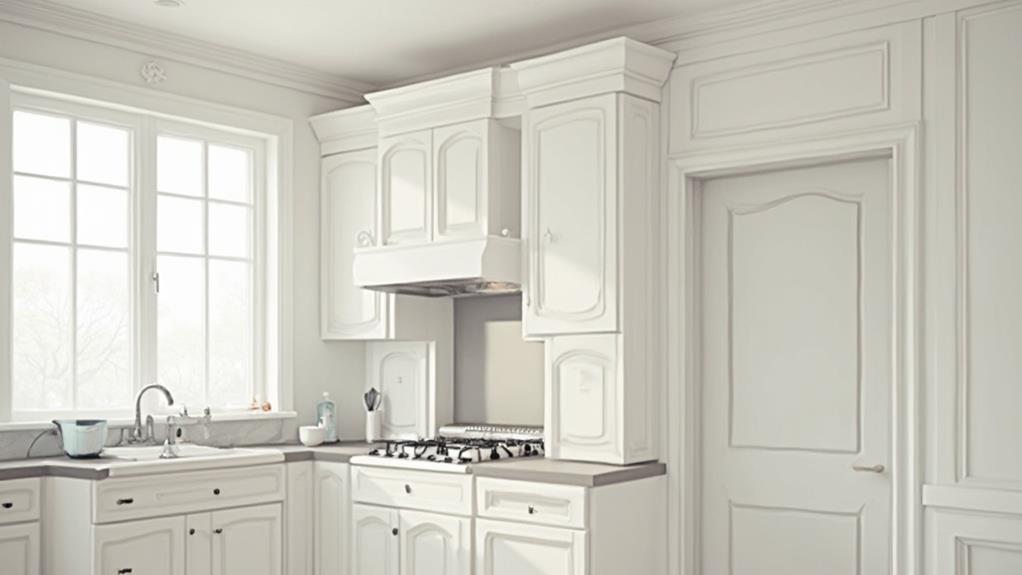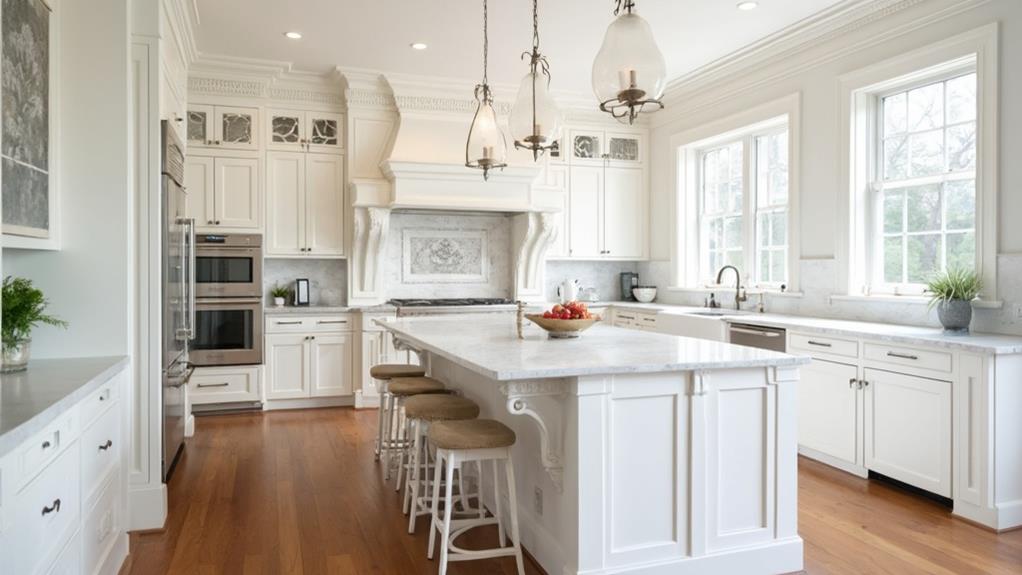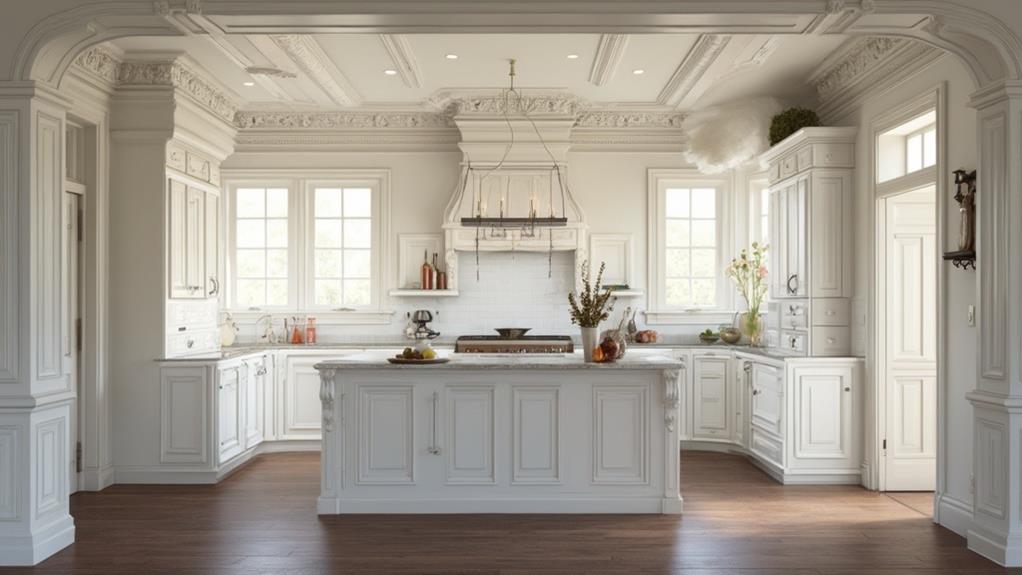Crown molding and trim work can dramatically enhance your kitchen's character and appeal. They define room boundaries, create seamless transitions, and highlight custom features. You'll find various styles and materials to suit traditional, modern, or transitional aesthetics. These elements can also manipulate space perception, making ceilings appear higher or rooms feel wider. In practical applications, they conceal gaps, frame architectural elements, and create cohesive looks. Current trends lean towards sleek designs, sustainable materials, and integration with smart technology. By understanding the impact of crown molding and trim work, you'll unlock the potential to transform your kitchen's entire look and feel.
Enhancing Architectural Character

When designing a kitchen, enhancing its architectural character is crucial for creating a cohesive and visually appealing space. Crown molding and trim work play a significant role in achieving this goal. By adding these elements, you'll define the room's boundaries and create a seamless transition between walls and ceilings.
Consider the existing architectural style of your home when selecting crown molding and trim. For a traditional kitchen, opt for ornate profiles with detailed carvings. In modern spaces, choose sleek, minimal designs that complement clean lines. You can use crown molding to highlight custom cabinetry, framing it to create a built-in look.
Don't overlook the power of baseboards and chair rails. These elements add depth and protection to your walls while contributing to the overall aesthetic. For a unified look, match the style of your trim work to your cabinet detailing.
To maximize impact, paint your crown molding and trim in a contrasting color to your walls. This technique draws the eye upward, making ceilings appear higher and the room more spacious. Alternatively, use the same color as your walls for a subtle, sophisticated effect.
Styles and Materials
Beyond architectural details, the styles and materials you choose for your kitchen will define its overall look and feel. When selecting crown molding and trim, consider the existing style of your home. For traditional kitchens, opt for ornate profiles with intricate details. Modern spaces benefit from sleek, minimalist designs with clean lines. Transitional kitchens can blend elements from both styles for a balanced look.
Materials play a crucial role in achieving your desired aesthetic. Wood remains a popular choice, offering versatility and warmth. Oak, maple, and cherry are durable options that can be stained or painted to match your cabinets. For a more budget-friendly alternative, consider medium-density fiberboard (MDF) or polyurethane, which can be molded into various shapes and painted to mimic wood.
In moisture-prone areas, choose materials resistant to warping and swelling. PVC and composite trims are excellent choices for their durability and low maintenance. For a luxurious touch, consider metal trims like brass or stainless steel, which can add a sophisticated accent to contemporary kitchens. Remember to coordinate your chosen style and material with other elements in your kitchen for a cohesive design.
Space Perception and Illusion

A few clever design tricks can dramatically alter the perception of space in your kitchen. Crown molding and trim work play a crucial role in creating these illusions. By drawing the eye upward, crown molding can make your ceilings appear higher, giving the impression of a larger, more open space. You'll find that installing molding where the walls meet the ceiling creates a seamless transition, softening corners and making the room feel more cohesive.
Vertical trim elements, such as pilasters or columns, can elongate walls and emphasize height. If you're dealing with a narrow kitchen, consider using horizontal trim work to create the illusion of width. Wainscoting or chair rails can visually widen a space by drawing the eye across the room. For low ceilings, opt for vertical paneling to create the illusion of height.
Light-colored trim against darker walls can make a space feel larger, while dark trim on light walls can add depth and dimension. You can also use trim to frame architectural features or create faux elements, like built-in cabinets or recessed panels, adding visual interest and perceived depth to your kitchen design.
Practical Applications in Kitchens
Let's dive into the practical applications of these design principles in kitchens. You can use crown molding and trim work to create visual illusions that enhance your kitchen's appearance and functionality. By installing crown molding along the top of your cabinets, you'll draw the eye upward, making your ceilings appear higher and your kitchen more spacious. This technique works particularly well in smaller kitchens or those with low ceilings.
For a cohesive look, consider matching your cabinet trim to your crown molding. This will create a seamless transition between different elements in your kitchen. You can also use trim work to frame windows or doorways, adding architectural interest and definition to these areas. If you have an open-concept kitchen, use molding to delineate the space without compromising the openness.
Don't forget about the practical benefits of trim work. It can help conceal gaps between cabinets and walls, creating a polished, finished look. You can also use it to hide under-cabinet lighting or to create a decorative backsplash. By strategically placing trim, you'll not only enhance your kitchen's aesthetics but also improve its functionality.
Design Trends and Innovations

While traditional kitchen design elements like crown molding and trim work remain popular, the world of kitchen design is constantly evolving. You'll find that modern trends are embracing sleek, minimalist aesthetics with clean lines and uncluttered spaces. Smart technology integration is on the rise, with voice-activated appliances and touchless faucets becoming more common.
Open-concept layouts continue to dominate, but you'll see a shift towards "broken-plan" designs that offer more defined zones within the space. Sustainable materials like bamboo and recycled glass are gaining traction, reflecting a growing eco-consciousness among homeowners.
Color trends are moving away from all-white kitchens, with bold, contrasting hues making a comeback. You'll notice an increase in two-tone cabinetry and colorful appliances that serve as statement pieces. Textured finishes, such as matte or brushed surfaces, are replacing glossy ones for a more tactile experience.
Innovative storage solutions are addressing the need for maximized space efficiency. You'll find pull-out pantries, hidden appliance garages, and multi-functional islands that adapt to your changing needs. These design trends and innovations are reshaping kitchens into more functional, personalized, and aesthetically pleasing spaces.
Conclusion
You've seen how crown molding and trim work can transform your kitchen from bland to grand. While these elements add sophistication, they're also practical, hiding imperfections and creating visual interest. You'll find endless possibilities in styles and materials, from classic wood to modern metals. As you plan your kitchen design, don't overlook these seemingly small details—they're the difference between a cookie-cutter space and a custom culinary haven that's uniquely yours.

